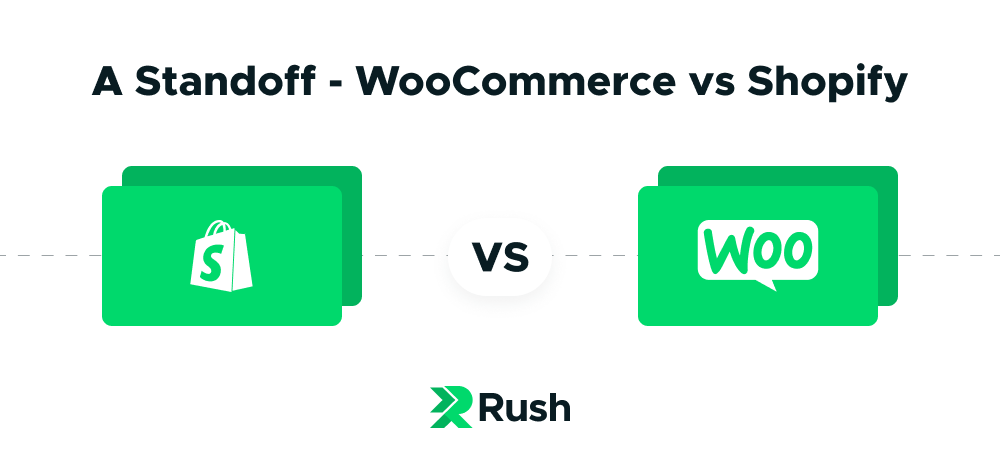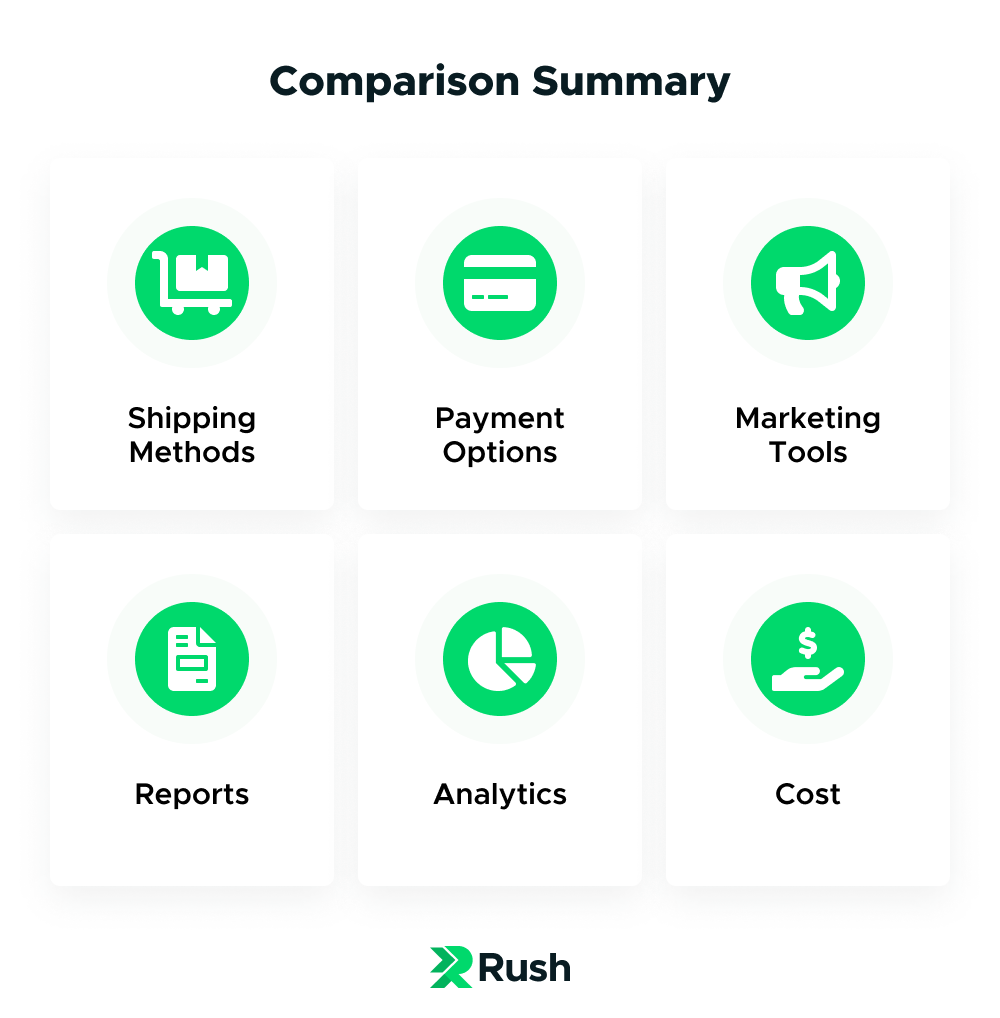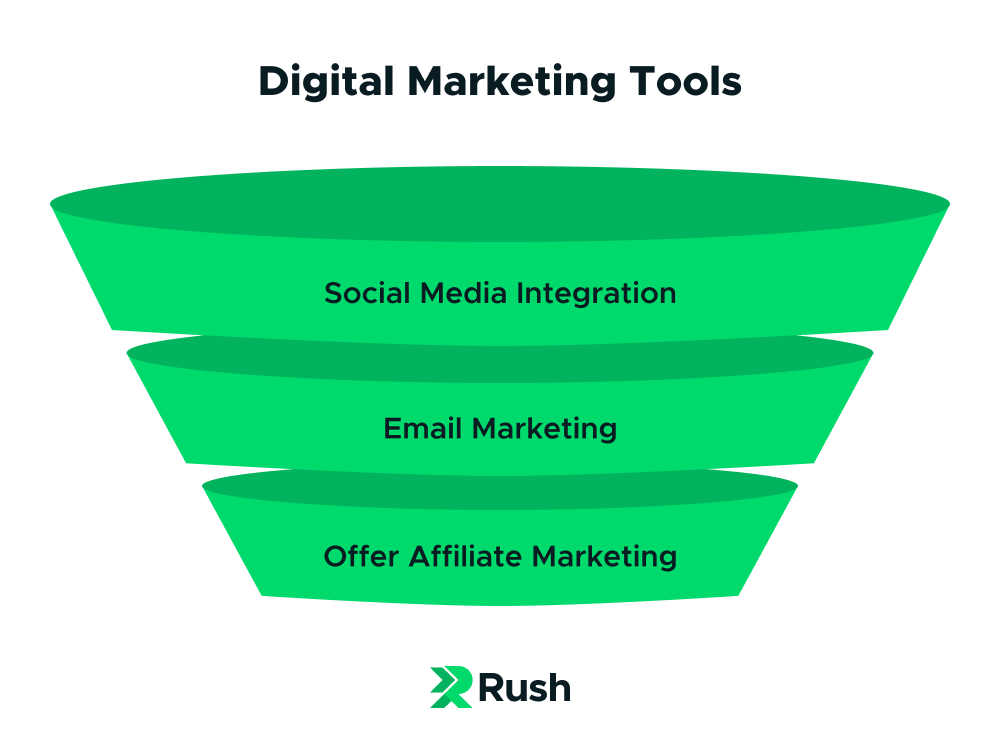eCommerce is a dynamic landscape — and choosing the right platform can make or break your online business. Shopify and WooCommerce are two giant options that stand out in this arena, and both have significant market shares.
This Shopify vs. WooCommerce showdown will compare the strengths, capabilities, pricing, and unique features of the platforms.
Shopify vs. WooCommerce: A Quick Comparison

| | |
|---|
| Perfectly designed for beginners and newbies. You don’t need to use any code to build an online store. | You need to have some coding knowledge to use WooCommerce otherwise, it might be a struggle, unlike with Shopify. |
| Shopify comes with an easy store-building process, which gets your store set up in less time. You can also install apps for different functions and features. | WooCommerce gives you full control over how you want your store to be — which means you need to be familiar with the features, codes, and other aspects of your store. |
| Shopify offers a list of paid and free themes. They come with multiple design variations and access to modify the outlook as per your liking. | WooCommerce offers simple and minimal design themes. There are plenty of customization features and options to let you have the outlook you want. |
| Shopify comes with built-in sales features like abandoned cart recovery, discount codes, unlimited products, blog features, and over 100 payment options. | WooCommerce lets you install plugins and extensions to access multiple sales features. |
| The Shopify app store has over 8,000 apps and easily integrates with many platforms. | WooCommerce is an open-source platform and its plugin directory comes with over 55,000 apps. |
| With Shopify, you can leverage multichannel selling on platforms like Amazon, Facebook, TikTok, Instagram, eBay, and Pinterest. | You can access all marketing tools in WooCommerce with plugins and extensions. |
| Shopify has heightened its game by offering an SEO app, best practice prompts, and keyword support. | WooCommerce is SEO-friendly and allows you to install popular SEO apps like Yoast for better SEO optimization. |
| Shopify has an active 24/7 live chat support. You can get your issues resolved around the clock. | WooCommerce has all the support you need — technical documentation, community, and live chat. |
| Though Shopify is considered cheaper in terms of security payments and hosting costs, themes can make it slightly expensive. | WooCommerce is a good value for the money and comes with a very low cost. Hosting is the main cost of WooCommerce. |
| | |
WooCommerce vs. Shopify
Shipping Methods
A range of features is offered by Shopify and WooCommerce to streamline the shipping process. Let’s have a closer look at how these features are.
Built-in Options
This Shopify vs. WooCommerce showdown will compare the strengths, capabilities, pricing, and unique features of the platforms.
- Shopify: Shopify comes with built-in shopping profiles, allowing store owners to set up shipping rates considering the product weight, order value, or quantity. You can print shipping labels directly from the dashboard, and it supports dropshipping with apps like Oberlo. Shopify Shipping is another quality feature designed for U.S. merchants offering discounted shipping rates with carriers like USPS, UPS, and DHL.
- WooCommerce: There are built-in shipping zones in WooCommerce, allowing for location-based shipping setups. eCommerce businesses and store owners can define flat rates, free shipping, or local pickup methods for each zone. For advanced options like table rate shipping or distance-based rates, you’d need plugins.
Shipping Carrier Integrations
- Shopify: You can seamlessly integrate your Shopify eCommerce store with shipping carriers — USPS, DHL Express, UPS, and Canada Post. The integration helps in calculating real-time shipping rates, tracking shipping updates, and label printing directly from the Shopify dashboard. You can also install other shipment tracking apps to help you offer a great post-purchase experience.
- WooCommerce: In WooCommerce, you need plugins to integrate shipping carriers. With the right plugin, you can integrate any carrier.
Shipping Rate Calculator
- Shopify: There’s a built-in shipping rate calculator in Shopify that provides real-time shipping estimates for customers based on their cart contents and locations. This feature is beneficial for stores using carrier-calculated shipping, which is included in the Advanced Shopify plan or can be added to the lower-tier plans for an additional fee.
- WooCommerce: There’s a basic shipping calculator available on the cart page in WooCommerce. It allows customers to estimate shipping costs based on their location. However, for real-time carrier rates, store owners would need to use plugins to access and display details of specific shipping carriers.
Payment Options
WooCommerce and Shopify, both platforms, offer robust payment solutions tailored to help you with a range of business needs. Shopify offers a more streamlined experience with Shopify Payments but charges a fee for a single external gateway.
WooCommerce is known for its unparalleled flexibility and doesn’t charge transaction fees but requires setup and configuration.
Supported Payment gateways
- Shopify: Shopify has its own payment solution, Shopify Payments, which is powered by Stripe. It supports over 100 third-party payment gateways, including PayPal, Apple Pay, Amazon Pay, and more. With the wide range of options, businesses can choose a payment method that suits their needs.
- WooCommerce: WooCommerce natively supports PayPal and Stripe. However, you can add any other payment options via a plugin, i.e., Square, Braintree, and more.
Transaction Fees
- Shopify: The integrated payment gateway, Shopify Payments, doesn’t charge you an additional transaction fee. However, if you use an external payment option, you will be charged a transaction fee that ranges between 0.5% to 2% based on the subscription plan you are on. This fee is separated from the external fees charged by the payment service.
- WooCommerce: There is no transaction fee in WooCommerce. However, you will be paying the fees of the payment gateway you are using. For instance, you won’t be charged a fee for using PayPal in WooCommerce. But PayPal itself will charge you a transaction fee.
International Payments
- Shopify: Shopify Payments supports multiple currencies, allowing customers to shop online and checkout in their local currency. This is an advantage for stores targeting international markets. With the wide range of support payment options, international payments have become hassle-free.
- WooCommerce: With the right plugins, you can support multi-currency shopping experiences. For instance, the WooCommerce Currency Switcher plugin can be a game changer. It displays prices and accepts payments in various currencies.
Marketing Tools
Marketing is the linchpin that drives sales in the eCommerce business. With the right marketing tools, you can engage with your customers, connect on a deeper level, nurture leads, and increase conversions and sales.
WooCommerce and Shopify both platforms come with a suite of marketing tools, but they stack up against each other in several parameters.
Email Marketing
- Shopify: Being a market-leading platform, Shopify comes with its own email marketing tool, Shopify Email. It allows store owners to create, run, and track email campaigns directly from the Shopify dashboard. You can also install other email marketing apps from the app store.
- WooCommerce: Though WooCommerce doesn’t offer a built-in email marketing solution, its open-source infrastructure allows you to integrate popular email marketing platforms like Mailchimp, SendinBlue, and others via the plugin.
Social Media Integration
- Shopify: Shopify seamlessly integrates with major social media platforms — Facebook, Instagram, and others — to offer multi-channel marketing. Store owners can leverage the power of social channels to connect with online audiences at no additional cost.
- WooCommerce: WooCommerce supports social media integration through various plugins. You can connect your eCommerce store to social channels in minutes. With social media integration, you can set up a shop on Facebook and Instagram, run ads, and even tag products in the viral posts you have for easy conversions.
Offer Affiliate Marketing
- Shopify: Shopify allows you to grow your business with the power of affiliates. It provides plugins like Refersion and Affiliatly. With the help of these apps, you can create and manage affiliate programs, affiliate promotion and signups, track conversion, and automate affiliate commissions.
- WooCommerce: WooCommerce also enables you to grow your business with the help of plugins like AffiliateWP or YITH WooCommerce Affiliates. These plugins allow you to set affiliate programs, track referrals, and manage commission payouts.
SEO Features
- Shopify: Shopify has its own built-in SEO features to help you optimize your store for better organic results. You can edit meta titles, descriptions, and URLs for product pages and blog posts. Plus, it automatically generates a sitemap.xml file, making it easier for search engines to crawl and index.
- WooCommerce: With WooCommerce, you need to get help from other SEO plugins like Yoast SEO or RankMath. These plugins give you full control and help you optimize each and every page of your store for better search results.
Reports and Analytics
Analytics reports give you insights into how your store is doing. Understanding your store’s performance is crucial. Both tools, WooCommerce and Shopify, offer reports and analytics but with a different set of features.
Built-In Reporting Tools
- Shopify: Shopify has an intuitively designed, appealing analytics dashboard. It displays a comprehensive overview of your store’s performance, including sales, visitors, and order trends. On the Advance plan subscription, you can look into deeper insights — sales attributed to marketing campaigns, customer behaviors, and more — for in-depth analysis.
- WooCommerce: Basic reporting and analytics features are available in WooCommerce (integrated with Google Analytics). These can provide you with insights into sales, orders, and customers. The Analytics dashboard provides a quick view of net and gross sales, order counts, and more. You can apply filters such as date range, product, category, and even by individual customers.
Integration with External Analytics Tools
- Shopify: You can seamlessly integrate your Shopify account with Google Analytics and track rich data, such as user interactions, eCommerce events, or set up funnels. For advanced analytics, you can install apps from the Shopify app store to get your hands on more advanced analytics.
- WooCommerce: In terms of flexibility in integrating external analytics tools, WooCommerce has no competition. There are a plethora of analytics tools that can be integrated with WooCommerce. Google Analytics can be integrated by using a free plugin to access insights into traffic sources, user behavior, and eCommerce tracking.
Custom Reporting and Data Exports
- Shopify: In Shopify, custom reports are only available in the Advanced plan. It allows you to create custom reports based on the metrics valuable for your business. These reports can be downloaded in CSV format
- WooCommerce: Custom reporting in WooCommerce can work through various plugins. With the right tools, you can create detailed custom reports that meet your needs. These reports are easily downloadable.
Cost
Cost is a significant factor in determining the eCommerce platform you would use. Shopify and WooCommerce have different pricing structures.
Initial setup coats
- Shopify: Shopify has a straightforward pricing model with three main pricing plans: Basic ($25 per month), Shopify ($65 per month), and Advanced ($399 per month).
- WooCommerce: WooCommerce is a free, open-source plugin for WordPress. The initial cost of WooCommerce is zero. However, to get started, you would need to pay for hosting, SSL, and a domain name — which will be costly.
Transaction Fees
Shopify: Shopify charges transaction fees unless you use its payment gateway, Shopify Payments. The transaction fee will be a 2% fee on all transactions of the Basic Shopify plan, 1% on the Shopify plan, and 0.5% on the Advanced Shopify plan.
- WooCommerce: There are no transaction fees in WooCommerce. However, payment gateways like PayPal, Stripe, or any other will have their own fees, typically around 2.9% + 30¢ per transaction.
Premium themes and plugins
Shopify: In the Shopify Theme Store, both premium and free themes are available. The price range of premium themes ranges from $140 to $180. The Shopify Plugin store also contains both free and paid plugins with varying prices.
- WooCommerce: Though there are several free themes available in WooCommerce, premium themes can range from $25 to $100+. There are several plugins available in WooCommerce, with free versions in the majority of them.
Ongoing maintenance costs
Shopify: Shopify is a hosted platform and covers hosting, backups, and updates within its monthly fees. You won’t have to pay any additional cost to maintain the platform
- WooCommerce: In WooCommerce, you are responsible for updates, backups, and security. Free plugins and themes can do a lot of things and offer various features, but for backups, security, and performance optimization, you might add to the costs, which may increase with your store’s growth.
Shopify vs. WooCommerce FAQs
Is Shopify better than WooCommerce?
Shopify and WooCommerce both come with quality options; one is well-equipped, and the other one gives you control over everything with more opportunities. It depends on your levels of expertise, knowledge of the market, and a grasp of what you want to create. Both Shopify and WooCommerce are good choices only if your goals are aligned.
Is Shopify better than WooCommerce?
Though Shopify offers built-in SEO solutions, WooCommerce lets you work with market-leading SEO solutions. With that being said, Shopify is a good option if you want to make things easier and faster as a beginner. WooCommerce is more suited to individuals with WordPress experience.
Is it worth moving from WooCommerce to Shopify?
It totally depends on your needs and end goals. If you seek a more hands-off approach, with little to worry about what to do at every step, then Shopify is the ideal pick for you. However, if you value customization and want to go beyond limits, then WooCommerce can facilitate your strategy.
Shopify and WooCommerce Comparison Summary
Shopify and WooCommerce both are market-leading platforms.
While Shopify has straightforward pricing plans, a built-in payment gateway, shopping options, and marketing tools, WooCommerce allows you to work with your favorite tools to build the store you dreamed of.
If Shopify scores higher on certain features, WooCommerce has no competition in certain capabilities. Hence, the choice between the two platforms hinges on the individual levels.
Each platform has its strengths, and your choice of platform should align with your business’s specific needs, technical comfort level, and future growth plans.



